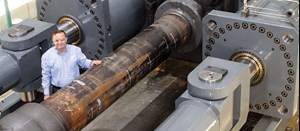Innovative Thinkers
Dr. Jim Kaculi says he always “had a great desire to learn.” He says this quality was largely imparted by his late father, who worked on a farm in Albania, on southeastern Europe’s Balkan Peninsula, to provide for his eight children. Although his father lacked an education of his own, he recognized its importance and encouraged all of his children to interminably continue learning.

“It was obvious that I had a talent for math and science as early as the first grade,” Kaculi said. “I was very interested in applying science to something you can touch and use.” This ultimately drove him to pursue a BS degree in mechanical engineering at Universiteti Politeknik i Tiranёs (Polytechnic University of Tirana).
After earning his degree, Kaculi went in pursuit of the “American dream” in 1995. He says he came to the U.S. with nothing in his pockets and little understanding of the English language. While working odd jobs, Kaculi taught himself to speak the language before enrolling at Lamar University in Beaumont, Texas.
While working toward his Doctorate degree at Lamar, Kaculi says he met Dril-Quip’s president and CEO Blake DeBerry, who was manager of R&D at that time. He says he was intrigued by DeBerry’s description of the technology being developed in the offshore oil and gas industry. “I realized that this is a very complex industry, and I thought this could be where I can best apply and expand my knowledge,” said Kaculi.
By 2001, Kaculi had signed on as an analysis engineer at Dril-Quip, where he worked with a specialized analysis group to improve the company’s capabilities relating to advanced computer simulations, modeling and verification analysis.
Since then, Kaculi has held a variety of engineering and management roles within the company. Today, however, he serves as Dril-Quip’s V.P. of engineering, where he oversees the company’s R&D and engineering division. “This is a team effort that starts with the vision of [our] upper management, and ends with the great engineering thinkers and technicians that turn ideas into cutting-edge technology and products for our customers,” Kaculi explained. “The work we’ve done here goes beyond the industry standard requirement.”
The BigBore IIe subsea wellhead system, inclusive of the DXe connector, is one of the newest developments produced by Kaculi’s team of experts. According to Kaculi, the technology was “extensively analyzed and validation tested” for use in HPHT environments. “HPHT environments have pushed the limits of the equipment, so we must find new solutions and continue raising the bar,” he says. To do this, the BigBore IIe was designed with a casing hanger and seal assembly lockdown system that eliminates the need for secondary lockdown devices during drilling and production operations. This significantly reduces rig time by decreasing the number of trips required for installation and retrieval, down to five. This ultimately results in substantial cost-savings for the operator. Additional features of the wellhead system include superior fatigue performance, increased capacity, and reduced risk and HSE exposure.
“We’re not done yet,” Kaculi says of Dril-Quip’s R&D team. The company announced the establishment of a new HPHT R&D center last year, which will focus primarily on materials and products appropriate for deepwater, harsh environment and severe service applications. The facility, which is being built in Singapore, is expected to open next year. However, Kaculi says the company already has its R&D team of experts in place, and there is “a lot happening there in HPHT, using the latest technology.” ![]()
- The reserves replacement dilemma: Can intelligent digital technologies fill the supply gap? (March 2024)
- What's new in production (February 2024)
- Subsea technology- Corrosion monitoring: From failure to success (February 2024)
- U.S. operators reduce activity as crude prices plunge (February 2024)
- U.S. producing gas wells increase despite low prices (February 2024)
- U.S. oil and natural gas production hits record highs (February 2024)
- Applying ultra-deep LWD resistivity technology successfully in a SAGD operation (May 2019)
- Adoption of wireless intelligent completions advances (May 2019)
- Majors double down as takeaway crunch eases (April 2019)
- What’s new in well logging and formation evaluation (April 2019)
- Qualification of a 20,000-psi subsea BOP: A collaborative approach (February 2019)
- ConocoPhillips’ Greg Leveille sees rapid trajectory of technical advancement continuing (February 2019)


